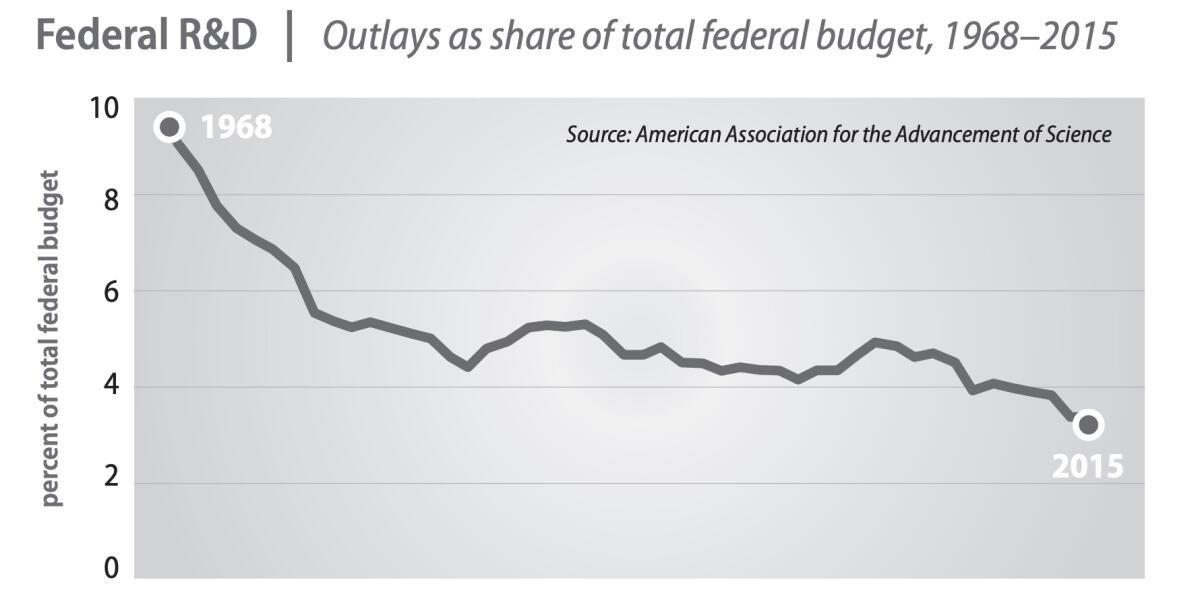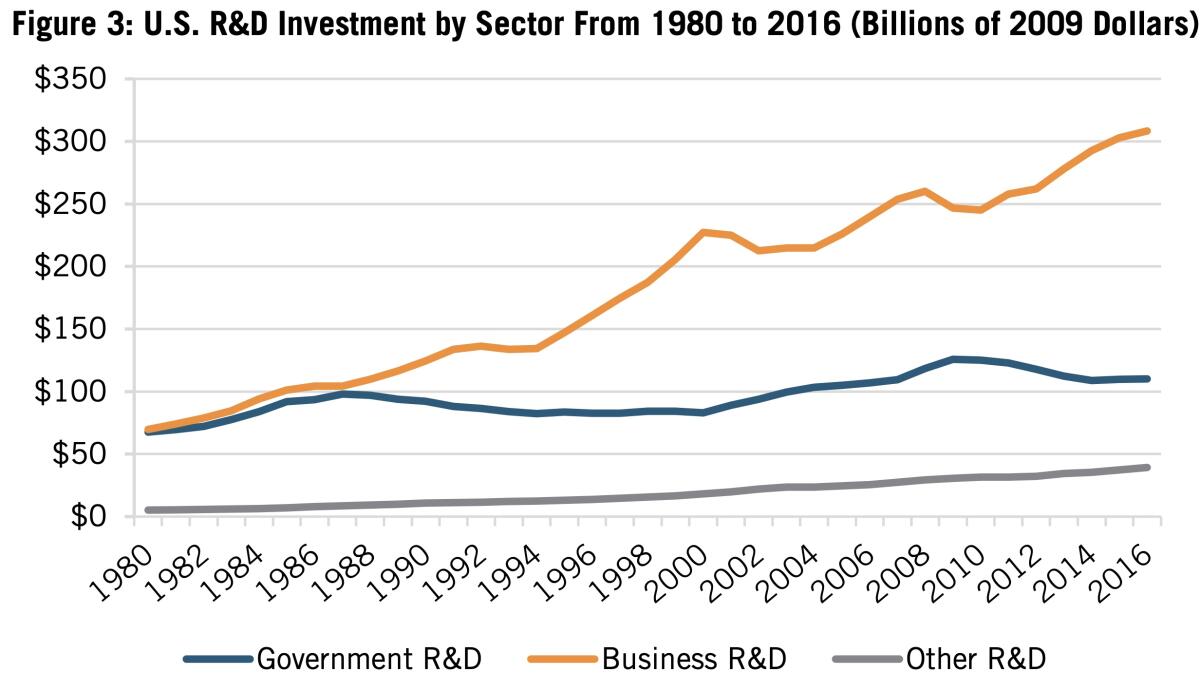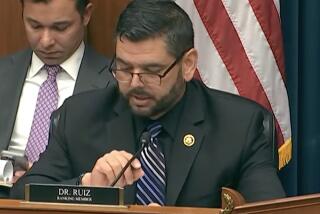Column: Americaâs poor record on COVID-19 reflects stagnant federal science funding
Among the many ways that the coronavirus crisis has exposed Americaâs decline as a world leader, one that has gotten insufficient attention is the federal governmentâs decline as a supporter of scientific research.
One can look at the consequences in several different ways. One certainly is the collapse of the American healthcare infrastructure in the face of a challenge that could more easily have been met with even minimally competent federal technological leadership.
Another is the governmentâs ceding responsibility for basic research to private enterprise, which doesnât like to do much of it. Then thereâs the politicization of science, which undermines institutional research and drains government programs of talented researchers.
Increasingly, as U.S. science investment stagnates, some of these breakthroughsâboth in fundamental research and in practical applicationsâare occurring outside the United States.
— MIT, âThe Future Postponedâ
The topic of Americaâs scientific preparedness has been receiving an airing lately against the backdrop of the pandemic.
Conservative economist Alex Tabarrok calls âthe failure to spend on actually fighting the virus with science...mind bogglingâ and âa stunning example of our inability to build.â (He frets that we spend too much on defense and âwelfare,â meaning Social Security, Medicare and Medicaid and not enough on âinnovation.â) Venture financier Marc Andreessen points to a âsmugâ absence of desire to invest in education, housing and other public goods.
Itâs fair to say that higher spending on basic research wouldnât necessarily have produced a more effective response to the coronavirus, since the virus is novel and many of its aspects still confound medical researchers.
Private enterprise, moreover, has been energized to research and, if warranted, manufacture treatments or a vaccine for the disease. If that happens, the power of American pharmaceutical manufacturing may show itself.
Kevin Drum of Mother Jones, who pointed us to Tabarrokâs analysis, aptly observes that the culprit in Americaâs pathetically slow rollout of COVID-19 testing hasnât been a lack of scientific research and development, but infrastructure and technology spending: âIt is disgraceful that weâve been so slow to roll this out, but itâs not really related to R&D.â
Heâs right about that, but the nationâs approach to the âDâ of R&D isnât entirely unrelated to its approach to the âR.â The record shows that the U.S. government has been increasingly indifferent, even hostile, to spending on basic scientific research, the seed corn of the possible development of treatments and a cure for COVID-19.
The trend dates back decades. But certainly it has picked up steam under President Trump, who has systematically stripped federal agencies of their scientific authority and, during the current crisis, seems to have paid little mind to the scientific advice heâs given.

Trumpâs anti-immigrant policies also threaten to choke off one of the traditional advantages of U.S. science, which is its receptiveness to students and scientists from abroad.
In just the last few days, according to Politico, the Trump administration cut off funding for a project supported by National Institutes of Health studying how coronaviruses jump from bats to humans, as the virus responsible for the current pandemic apparently did. The project involved collaboration with a scientific instituted in Wuhan, China, the city where the pandemic originated.
As weâve reported, since at least 2000, scientists have become increasingly concerned about âa growing U.S. innovation deficit,â as a 2015 report by MIT put it.
The report listed four landmark scientific breakthroughs of the prior year: the first spacecraft landing on a comet; the discovery of the Higgs boson, a new fundamental particle; the development of the worldâs fastest supercomputer; and new research in plant biology pointing to new ways to meet global food needs.
Then came the punchline: None was a U.S.-led achievement. The first two were the products of European-led consortia, and credit for the second two belonged to the Chinese â âreflecting that nationâs emergence as a science and technology power.â
The report attributed the absence of U.S. leadership in these innovations âin part to declining public investment in research.â In a follow-up report a year later, researchers from a dozen top research institutions examined tangible results from basic science, including an Ebola vaccine and a practical demonstration of the principle underlying quantum computing and ultra-secure quantum communications.
âIncreasingly, as U.S. science investment stagnates, some of these breakthroughs â both in fundamental research and in practical applications â are occurring outside the United States,â the researchers reported.
A new report from the Massachusetts Institute of Technology lists four landmark scientific achievements of the last year: the first spacecraft landing on a comet; the discovery of a new fundamental particle, the Higgs boson; the development of the worldâs fastest supercomputer; and new research in plant biology pointing to new ways to meet global food needs.
One field in which basic research was shortchanged, the MIT report noted, was the fight against infectious disease. Writing in 2015, the authors focused on Ebola, the most dangerous viral disease of the time, but their conclusions could apply almost as well to COVID-19.
The problem, the authors suggested, was an overreliance on âprivately funded research in pharmaceutical and biotechnology companies. The private sector was successful at devising âdrugs, tests, and procedures needed to combat the diseases of the developed world,â but âexisting priorities and incentives are not sufficient to prepare for diseases that emerge by jumping from animals to humans in impoverished parts of the developing world.â
Creating drugs and tests for known diseases is applied research. But âif we are to be prepared for the next viral epidemic, we need to invest in the basic research to characterize and understand all known viruses with the potential to be highly infectious,â the MIT report warned. Its words reverberate today.
Because private commercial companies seldom invest in research they canât reliably link to their core businesses, it falls to the public sector to fund basic research â for the same reason that government made the initial investments in basic infrastructure such as interstate highways, Hoover Dam and the internet.
Since about 1986, however, U.S. government investment in R&D has stagnated at around $100 billion a year, according to the nonprofit Information Technology and Innovation Foundation (with a brief spike to $126 billion in 2009, due to the post-crash stimulus). Business R&D, however increased from $70 billion in 1980 to $300 billion in 2016, an increase of 340%.
Itâs fair to say that higher spending on basic research wouldnât necessarily have produced a more effective response to the coronavirus pandemic, since the virus is novel and many aspects of the infection it produces in humans still confounds medical researchers. Private enterprise, moreover, has been energized to research and, if warranted, manufacture treatments or a vaccine for the disease.
Itâs also true that, while Americaâs funding of basic research has remained stagnant in dollars and declined in relation to the burgeoning growth in its economy, the absolute numbers remain impressive.

The $100 billion a year spent by U.S. government agencies is more than that of any other countryâs public sector, according to UNESCO. Chinaâs outlay of roughly $80 billion from the public sector and $300 billion from business adds up to about 2% of its gross domestic product spent on R&D of all forms, compared to 2.7% in the U.S.
Yet if we measure a countryâs commitment to R&D in relation to the size of its economy, the U.S. lands behind much smaller countries, including Germany (2.9%), Japan (3.4%), Israel (4.2%) and South Korea (4.3%).
In the U.S., basic research has long been hampered by political narrow-mindedness and ideological roadblocks. The U.S. abandoned its plan to build the worldâs most powerful atom-smasher, thus maintaining a lead first established at UC Berkeley with Ernest Lawrenceâs invention of the cyclotron, when Congress pulled the plug in 1993 after spending $2 billion.
Nobel physicist Steven Weinberg, a leader of the superconducting super collider project, recalled one telling encounter with a congressman who opposed the SSC. âHe said that he wasnât against spending on science, but that we had to set priorities. I explained that the SSC was going to help us learn the laws of nature, and I asked if that didnât deserve a high priority. I remember every word of his answer. It was âNo.ââ
The quest for the biggest, best atom-smasher was won by the Large Hadron Collider, which was built by a European team and achieved the breakthrough discovery of the Higgs boson.
In subsequent years, Republicans in Congress have tried to stifle research into climate change, presumably at the behest of their patrons in the fossil fuel industry. George W. Bush blocked research into embryonic stem cells, a bow to Christian conservatives who saw it as a violation of religious principles. (Bushâs action prompted California votes to create a $3-billion state stem cell program in 2004.)
Could a more robust approach to funding basic science have placed the U.S. in the lead in the fight against COVID-19? All that one can say is that allowing spending to stagnate didnât help. And in this crisis, we need all the help we can get.
More to Read
Inside the business of entertainment
The Wide Shot brings you news, analysis and insights on everything from streaming wars to production â and what it all means for the future.
You may occasionally receive promotional content from the Los Angeles Times.











